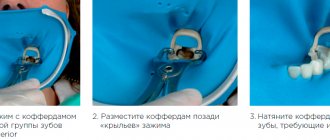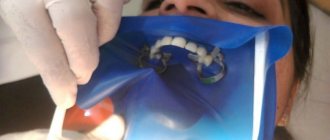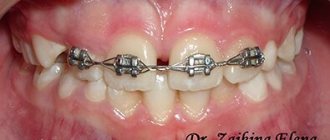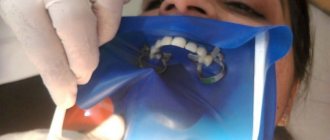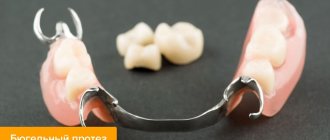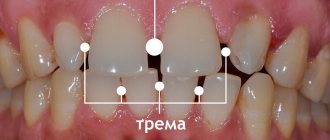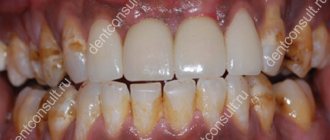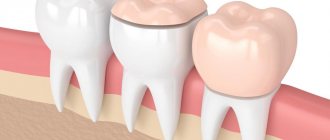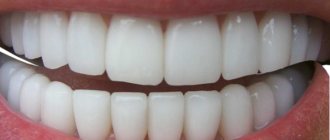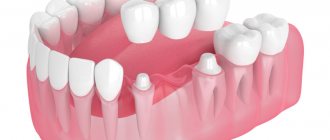What accessories do we need to install a rubber dam? In this article we will give a complete overview of what is needed for application and what helps make the procedure as simple as possible.
The following lists all the accessories needed to apply a rubber dam:
- Cofferdam clasps
- Forceps for applying rubber dam clasps (clamps)
- Rubber dam plate
- Rubber dam template and rubber dam stamp
- Perforator pliers
- Frames for rubber dam
- Latex thread (wedjets)
- Wipes for rubber dam
- Dental floss
- Water based lubricant
Let's look at each point separately.
Cofferdam clasps.
Clasps are necessary to hold the latex plate on the teeth. Each group of teeth has its own clasps.
As we can see, there are quite a lot of varieties of clasps. Each manufacturer gives recommendations on the use of a particular clasp on a specific tooth or group of teeth. But there are situations when it is better to use a clasp for another group of teeth, for example, on the upper third molars you can use clasps for premolars.
In addition to dividing into groups, there are clasps with and without wings:
Why is such a division needed? It is easier to install a latex plate on clasps with wings, and clasps without wings are indispensable when installing on second and third molars when the ramus of the lower jaw interferes, but more on this in the following articles.
Dental clinic No. 2
- Cofferdam clasps
- Forceps for applying rubber dam clasps (clamps)
- Rubber dam plate
- Rubber dam template and rubber dam stamp
- Perforator pliers
- Frames for rubber dam
- Latex thread (wedjets)
- Wipes for rubber dam
- Dental floss
- Water based lubricant
Cofferdam clasps
Clasps are necessary to hold the latex plate on the teeth. Each group of teeth has its own clasps.
As we can see, there are quite a lot of varieties of clasps. Each manufacturer gives recommendations on the use of a particular clasp on a specific tooth or group of teeth. But there are situations when it is better to use a clasp for another group of teeth, for example, on the upper third molars you can use clasps for premolars. In addition to dividing into groups, there are clasps with and without wings:
Why is such a division needed? It is easier to install a latex plate on clasps with wings, and clasps without wings are indispensable when installing on second and third molars when the ramus of the lower jaw interferes, but more on this in the following articles.
Forceps for applying rubber dam clasps (clamps)
There are various modifications. There is no fundamental difference between them, whatever is more convenient for you.
Rubber dam plate.
Standard plates are divided by thickness into:
- thin (thin) 0.13-0.18 mm - the thinnest rubber dam, the easier it is to apply, the faster it breaks and the tightness of its fit is not as good as that of a thicker one
- medium (medium) 0.18-0.23 mm – it is most suitable for use, as it is especially easy to handle, also convenient for pulling the rubber dam and, of course, for conservative treatment
- thick (heavy) 0.23-0.29 mm – thanks to its use, good gum retraction is achieved. In addition, it practically does not tear
- extra thick (xheavy) 0.29-0.34 mm - does not tear under extreme conditions and allows for maximum gum retraction, but at the same time it is very difficult to adapt
- thick special (spheavy) 0.34-0.39 mm - this rubber dam is applied only in cases where it is absolutely necessary to achieve special tissue protection.
The thickness, color and number of latex plates can be seen on the packaging. The rubber dam plate has a smooth and powdered surface. The smooth surface is always adjacent to the surface of the patient’s oral cavity, and the powdered one is thus facing the doctor. This rule must be observed for two reasons:
- smooth surface glides more easily over the surface of the teeth being isolated
- when the rubber dam comes into contact with the tongue, no rice or corn flour remains on the latter.
The curtain is also produced in different colors. Light colors: light beige, light blue, pink, lilac – are recommended for endodontic treatment. Due to the low contrast with the tooth tissues, they “reduce” the light details (tooth crown) to the background and “bring” the dark ones—the mouths of the root canals—to the foreground. Intense tones: brown, dark gray, green, blue – recommended for restoration. Sufficient contrast with the working area “brings” the light details of the tooth, that is, the crown, to the foreground, and “brings” the dark ones to the background. However, the color of the curtain should not create too much contrast, as this leads to rapid eye fatigue. With a strong contrast, for example, with a dark gray version of the curtain, after some time of work the tooth turns into a solid white spot, and it becomes difficult to see the details on the surface. In addition to standard plates, modified plates are also available. Reinforced rubber dam. This type is resistant to tearing; if damaged, the damage remains limited. The only negative is the difficulty of installation with tight interdental contacts.
Optidam. The latex plate has a concave surface, which creates additional working space and makes it easier to install the rubber dam. There is also no need for pliers to perforate holes.
Optradam. It is a latex plate stretched between two rings. This version of the rubber dam involves installation without the use of clasps. The disadvantages of this option are some pressure on the frenulum of the upper and lower lips by the vestibular ring and still the need for clasps when treating third and sometimes second molars.
Cofferdam template and rubber dam stamp.
Necessary for applying future holes to the latex plate.
Perforator pliers.
They come in different designs, but the function is the same - to make a hole of a certain diameter in the latex plate. Each such tool has a rotating part that adjusts the size of the hole.
Hole No. 5 (largest) – recommended for clasp teeth (at the end of the dental arch) Hole No. 4 (large) – universal for molars Hole No. 3 (medium) – for canines and premolars of the upper and lower jaws Hole No. 2 (small-small) – for the front teeth of the upper jaw Hole No. 1 (smallest-smallest) – for very thin lower front teeth
Frames for rubber dam.
Rubber dam frames come in a variety of shapes and materials and are designed to hold the edges of the latex plate. Among all the variety, it is worth noting that most of them are not entirely convenient for radiography. You have to at least remove the latex from the frame. But there are folding frames; during X-ray examination, half of the frame is simply folded to the side.
Latex thread (wedjets)
This thread holds the rubber dam by installing it in the interdental space.
There is also dental floss on sale with a fixing silicone insert - Fixafloss (Kerr).
Wipes for rubber dam.
The wipes are placed between the patient's face and the latex plate. Designed to reduce contact with facial skin and absorb leaking saliva.
Dental floss.
Necessary for pushing a latex plate between teeth and tying teeth during anterior restorations. Regular floss is used.
Water based lubricant.
Necessary for lubricating the edges of the holes in the latex plate for better insertion into the interdental spaces. For example Denta-glyde. Of course, you will not need all the accessories; for example, you can do without latex thread or lubricant, it all depends on the system used, the thickness of the latex, etc.
Rubber dam plate.
Standard plates are divided by thickness into:
- thin (thin) 0.13-0.18 mm - the thinnest rubber dam, the easier it is to apply, the faster it breaks and the tightness of its fit is not as good as that of a thicker one
- medium (medium) 0.18-0.23 mm – it is most suitable for use, as it is especially easy to handle, also convenient for pulling the rubber dam and, of course, for conservative treatment
- thick (heavy) 0.23-0.29 mm – thanks to its use, good gum retraction is achieved. In addition, it practically does not tear
- extra thick (xheavy) 0.29-0.34 mm - does not tear under extreme conditions and allows for maximum gum retraction, but at the same time it is very difficult to adapt
- thick special (spheavy) 0.34-0.39 mm - this rubber dam is applied only in cases where it is absolutely necessary to achieve special tissue protection.
Tools
The vast majority of dentists pay attention to the quality of workmanship and ergonomics of rubber dam instruments from Dentech Corporation. Everything is thought out to the smallest detail. For example, users highlight such a convenient feature of the pliers as the absence of balls on the tips for the easiest and most convenient installation/removal of clamps, as well as the presence of special screws for fixing the floss to the rubber dam frame.
All tools are reliable, made of high quality materials, and most importantly, they will last a long time. Dentech uses only the most modern technologies and equipment for development and production. The company has an excellent quality control system.
You can select and purchase rubberdam/cofferdam system tools from the Japanese company Dentech Corporation from an exclusive importer by following this link.
Perforator pliers.
They come in different designs, but the function is the same - to make a hole of a certain diameter in the latex plate.
Each such tool has a rotating part that adjusts the size of the hole.
- Hole No. 5 (largest) – recommended for clasp teeth (at the end of the dental arch)
- Hole No. 4 (large) – universal for molars
- Hole No. 3 (medium) – for canines and premolars of the upper and lower jaw
- Hole No. 2 (small) – for the front teeth of the upper jaw
- Hole No. 1 (smallest) – for very thin lower front teeth.
Water-based lubricant.
Necessary for lubricating the edges of the holes in the latex plate for better insertion into the interdental spaces. For example Denta-glyde.
Of course, you will not need all the accessories; for example, you can do without latex thread or lubricant, it all depends on the system used, the thickness of the latex, etc.
Now that everything is ready for use, you need to know how to apply a rubber dam. Let's study the first method of applying a rubber dam, more on that in the next article.
Did you like the article? Then leave your email so you don't miss anything interesting.
Sets
The rubber dam is not limited to latex sheets - it is a whole system of tools and additional materials. For full-fledged work, you need a sufficient number of clamps, a stand for storing and processing them, as well as a frame, a puncher, and tongs and additional accessories.
Of course, all of this can be purchased separately, but if you do not have any of the above, then it is better to purchase a ready-made set. This will help save time and money. The most popular and at the same time ideal in terms of configuration is the Dentech Technic Set starter tool kit. It includes 12 clamps and all the necessary tools for the rubber dam. Plus, the gift comes with a pack of DuraDam latex sheets, 36 pieces. Essentially, this kit offers everything you need to get started right away.
